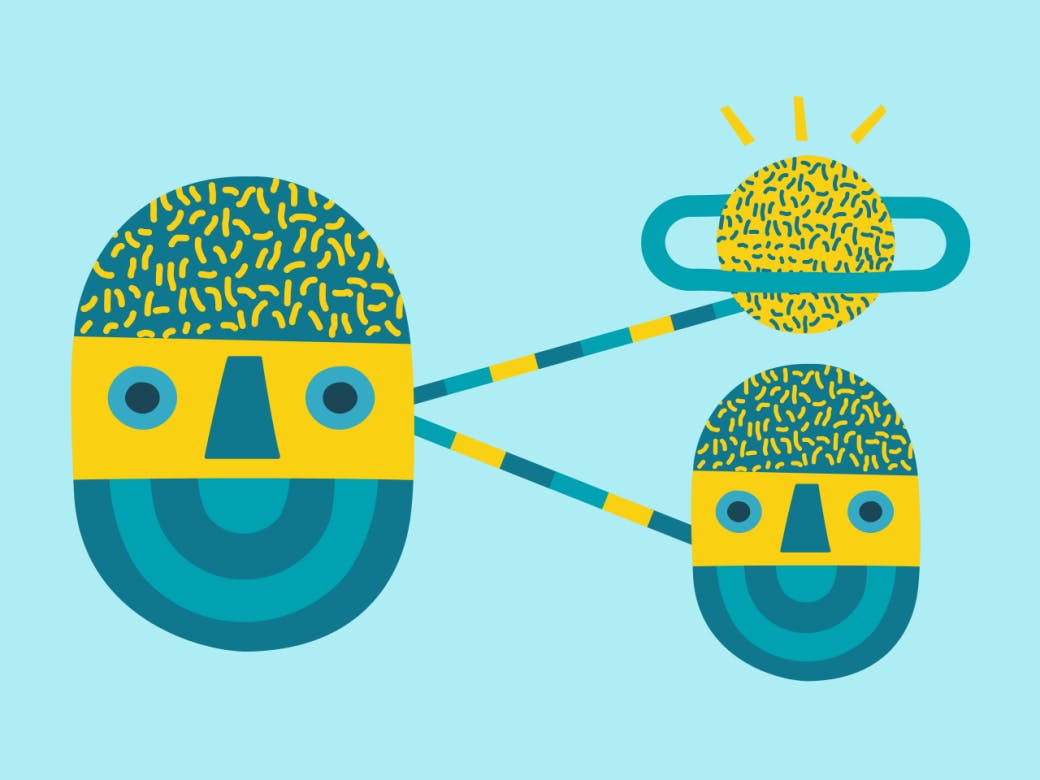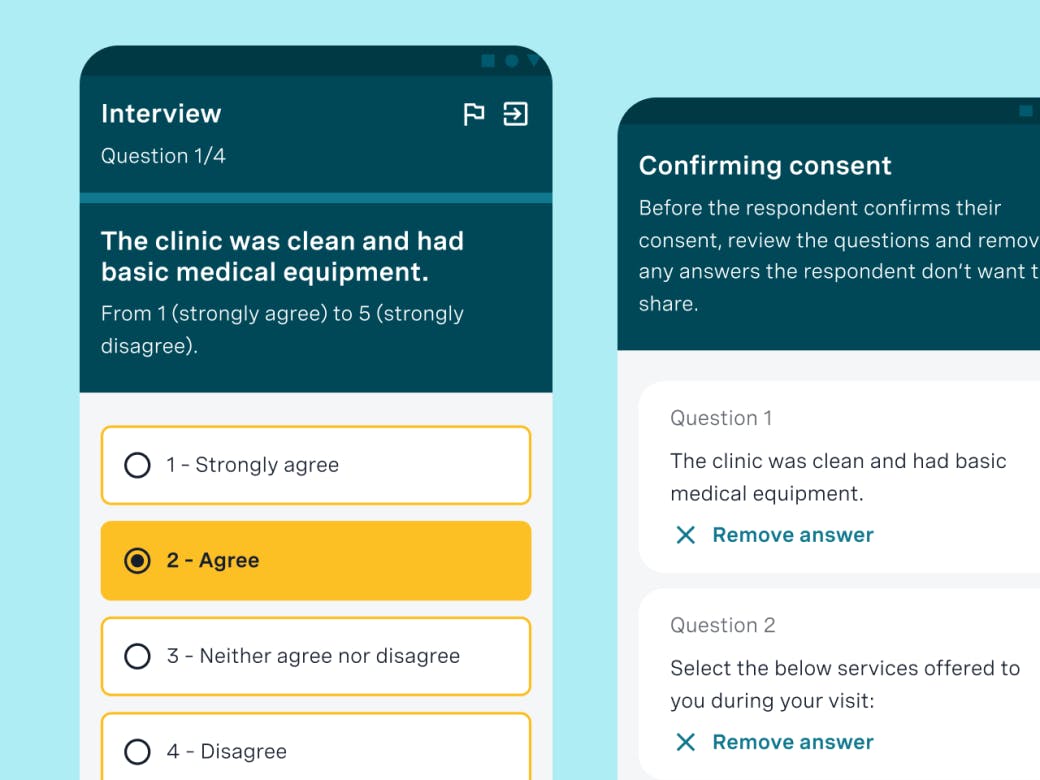Can informed UX gain (more) informed consent?
The mission of Fatima's creator, Here I Am, is to create digital ways to include the excluded. Those without the latest iOS, money for data credit, or a place to charge their phone each night. For people with a visual or hearing impairment, with anxiety, depression or PTSD. All of those who find the digital world hard to access, navigate, trust, and benefit from.
Here I Am create digital products and services to support different excluded communities around the world. We have a lot of experience developing research technologies that help excluded people have their voices respectfully heard and their needs rapidly met.
Over the years, we’ve found that one specific area of the research life cycle that needs serious improvement is, unsurprisingly, consent. The consent process is rarely respectful of the people taking part in research and typically involved pushing a piece of paper at a person who may have trouble processing new or complex concepts - for any number of reasons including:
- Lack of literacy
- Fear of repercussion from non-compliance
- PTSD / displacement trauma
The complicated terms and conditions for consent and lazily written forms that do not include the right information, make it even more difficult for people to fully comprehend what they are consenting to. This indecipherable consent form tended to then get quickly lost in an untraceable paper trail, making it impossible for the consenter to execute their right to be forgotten and other data rights, should they ever want to.
How is this informed consent? It’s not, and it never has been.
The good news is that a) technology exists today to indelibly outmode old, disrespectful paper-based consent approaches, and, b) over the last 7 years we* have been testing and refining how to do that.
The bad news is that during this time, ‘data’ has become a complex, mercurial, difficult-to-outrun beast. Finding simple, easy-to-understand ways to communicate it to ourselves, let alone to overwhelmed people with low literacy levels is still somewhat TBC.
Below we share where we got to in answering this question, and how we have created Fatima's consent process to be ethical and informed for all participants.
How can we use digital to increase propensity for informed consent from marginalised people?
We revamped the consent process based on some key assumptions about the people we are trying to gain informed consent from:
They may:
- Be suffering from trauma
- Have low literacy
- Not know what consent is
- Be intimidated by the process.
These factors create a reduced ability to concentrate, understand and retain information - all big barriers to being ‘informed’.
We took 5 steps to overcome these barriers and create a digital process that increases propensity for informed consent:
1. We digitised the process
From disseminating consent information to collecting consent, we digitised the process. This removes the challenge with unreliable, indecipherable paper trials. In digitising the approach into a rigid, linear UX, we are also able to quality control the process.

2. We eliminated text
Where possible, we eliminated text to overcome literacy barriers.
3. We broke information down into bite-sized pieces
Breaking information down into bite-sized pieces of information and using repetition are effective ways to overcome the issue of understanding and retaining information (as we’ll show below). So we broke the consent information down into smaller, more manageable pieces, and created a step-by-step process.
A bite-sized piece of information might be: ‘We are going to keep the information you share with us for 4 years’.
4. We verified comprehension
In between each piece of information is a pause. The participant is then asked a multiple choice question designed to understand their comprehension of that information:
Eg. How long are we going to keep your information?
a) 4 days
b) 4 years
c) Forever
If the participant answers this question correctly, the next piece of information is unlocked. If the participant answers incorrectly, the information is repeated. This cycle can be repeated 3 times. If after 3 tries, the participant hasn’t answered correctly, informed consent collection is not deemed possible and the process is stopped.

The cycle of verbalising pieces of information, and verifying comprehension is repeated until all information has been shared, and understood.
The interview / research can now commence. Throughout the interview, the participant can choose to stop the interview at any time.
5. Post interview, we regain ‘selective consent’
Mindful that pre-interview, the participant will not know a) the questions they will be asked, b) the information they will share in response and c) an ‘interview’ may be an unfamiliar concept, once the interview is complete, we regain consent on a general level as well as on an individual response level by asking:
‘Based on the information you have shared with us, are you still happy for us to keep your information?’ ‘Are there any answers you would like us to remove?’
Our approach allows the easy deletion of responses not just on an overall survey basis, but also on an individual response basis, enabling what we call ‘selective consent’.
If the participant decides they don’t want to share any or some information, it’s automatically and entirely deleted. Only once the participant has verified the information they would like to share, it is uploaded and securely stored on Fatima's Research Hub.

Our 7 year improvement cycle has led us to these 5 steps for optimising consent through digital, and specifically UX. Combined, they increase the likelihood that the consent process is fully understood by anyone being asked to take part in research. It’s not perfect, but it's a proven improvement.
How do we know it works?
More people are opting out!
Since deploying this informed consent approach, we’ve found that more people are declining to participate in the research. This might sound like a bad thing, but actually it's a great sign that participants are a) aware of what they are being asked to consent to, and b) know that it's okay not to participate.
Saying ‘no’ is the normal behaviour of informed people.
The area we want to focus on improving next is ensuring that the participant has a memorable route back to the data collector and their data, to enable them to easily execute their right to be forgotten, even if this is years after the interview has taken place. If you have any good suggestions or techniques, we would love to hear from you!
Thank you
We* = Here I Am, Girl Effect, CARE International, Malala Fund, Youth Endowment Fund, Young Foundation, Linda Raftree and Zoe Dibb.
Try Fatima for free
Why not try Fatima for yourself? Sign up to try Fatima for free and make your next project an ethical research experience for all involved.



